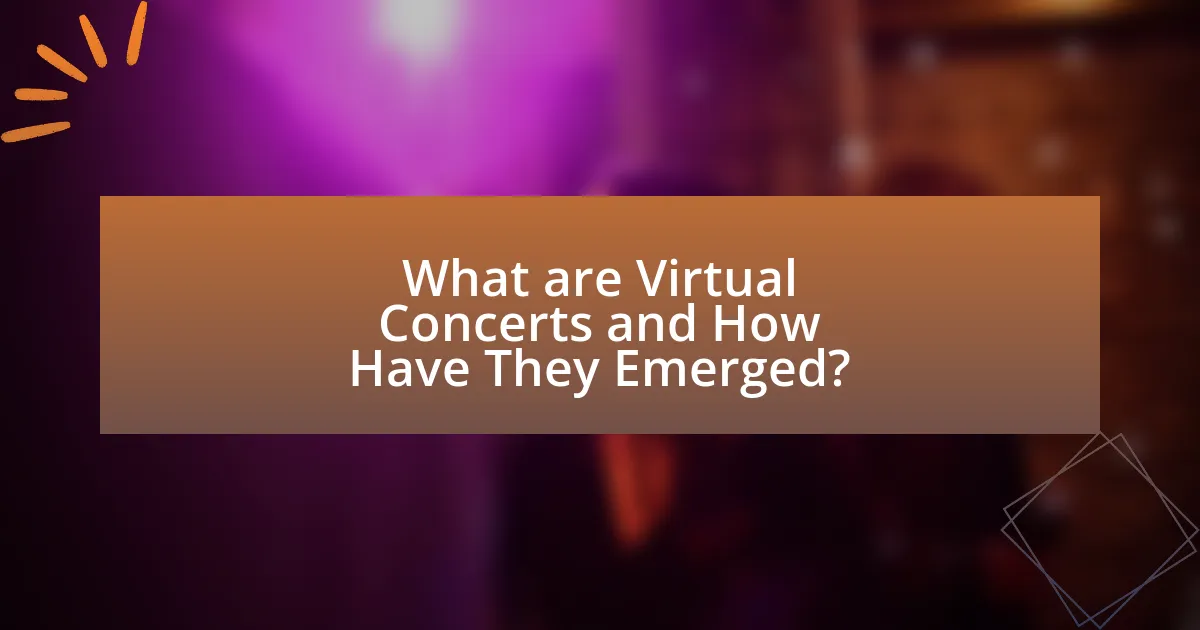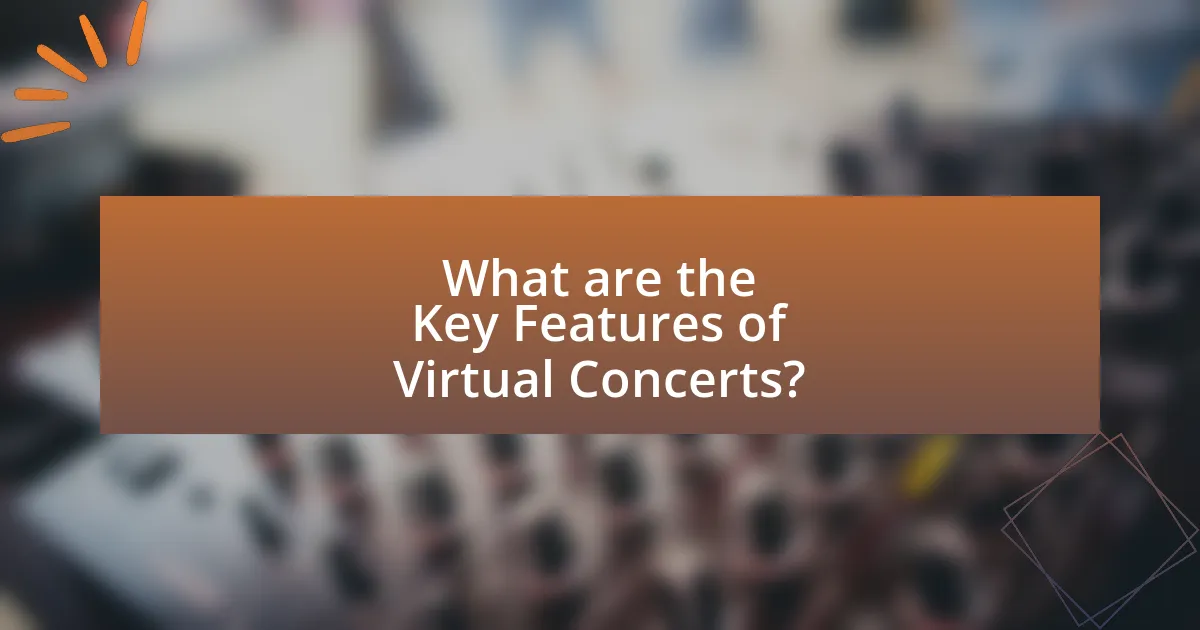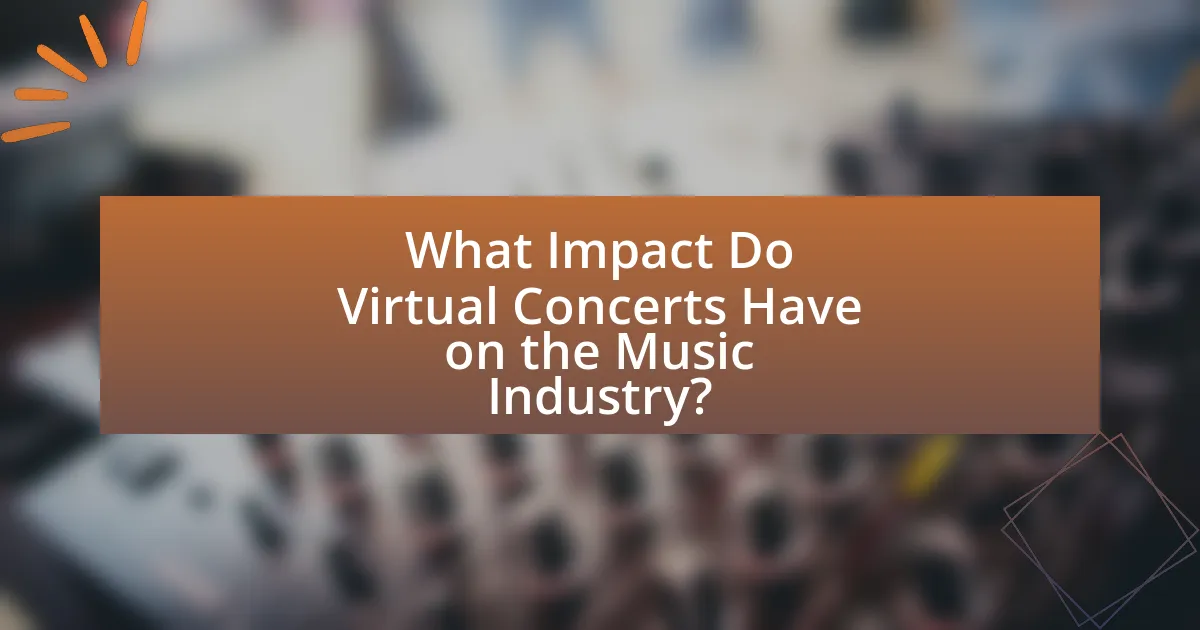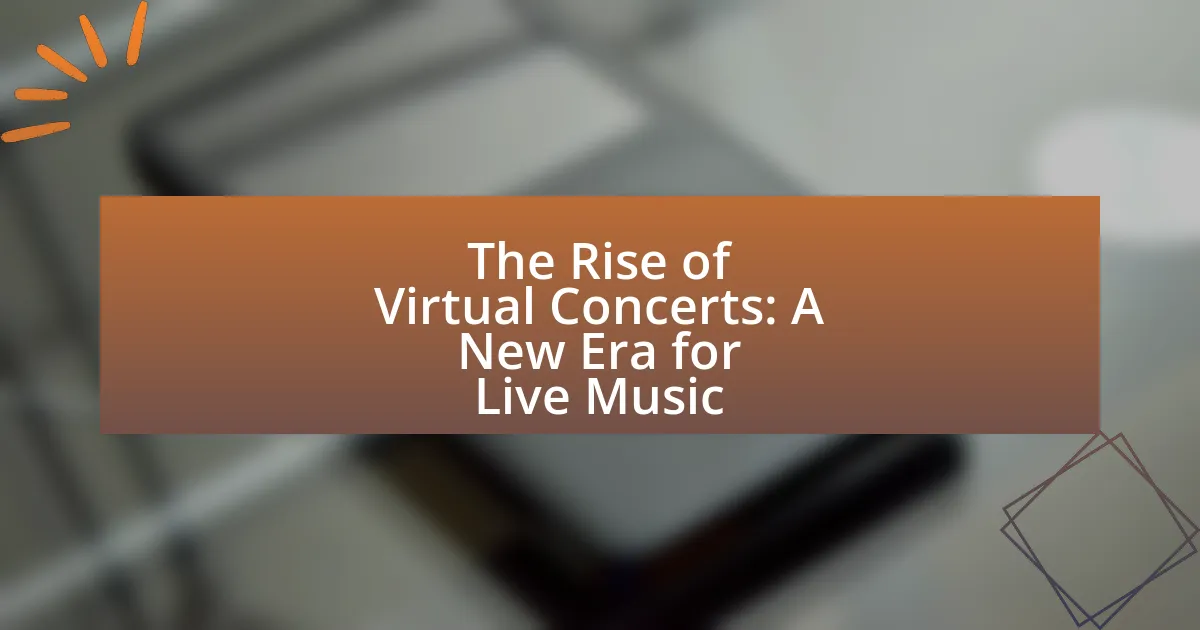Virtual concerts are live music performances streamed in a digital environment, allowing audiences to engage remotely. Their emergence has been significantly influenced by advancements in technology and the COVID-19 pandemic, which necessitated alternative entertainment options. This article explores the definition of virtual concerts, their differences from traditional live performances, the technologies that enable them, and their growing popularity. It also examines the impact of virtual concerts on the music industry, including new revenue streams for artists, audience engagement, and the challenges faced in this evolving landscape. Key features, types, and best practices for hosting and attending virtual concerts are also discussed, highlighting the transformative nature of this new era for live music.

What are Virtual Concerts and How Have They Emerged?
Virtual concerts are live music performances that occur in a digital environment, allowing audiences to experience the event remotely through streaming technology. They have emerged significantly due to advancements in internet connectivity and the necessity for social distancing during the COVID-19 pandemic, which prompted artists and venues to seek alternative ways to engage with fans. For instance, in 2020, platforms like Twitch and YouTube saw a surge in virtual events, with notable performances such as Travis Scott’s concert in Fortnite attracting over 12 million viewers, illustrating the potential reach and impact of virtual concerts in the music industry.
What defines a virtual concert?
A virtual concert is defined as a live musical performance that is streamed online, allowing audiences to experience the event remotely. This format utilizes digital platforms to broadcast performances, enabling artists to reach global audiences without physical venue limitations. The rise of virtual concerts has been significantly influenced by advancements in technology and the need for alternative entertainment options, particularly during events like the COVID-19 pandemic, which restricted in-person gatherings. For instance, in 2020, Travis Scott’s virtual concert in Fortnite attracted over 12 million viewers, showcasing the potential scale and engagement of such events.
How do virtual concerts differ from traditional live concerts?
Virtual concerts differ from traditional live concerts primarily in their format and accessibility. Traditional live concerts occur in physical venues where audiences gather to experience performances in person, while virtual concerts are streamed online, allowing viewers to participate from anywhere with an internet connection. This shift to a digital platform has enabled artists to reach a global audience without geographical limitations, as evidenced by events like Travis Scott’s virtual concert in Fortnite, which attracted over 12 million viewers simultaneously. Additionally, virtual concerts often incorporate interactive elements, such as real-time chat and augmented reality features, enhancing audience engagement in ways that traditional concerts cannot.
What technologies enable virtual concerts?
Virtual concerts are enabled by technologies such as high-speed internet, virtual reality (VR), augmented reality (AR), live streaming platforms, and interactive software. High-speed internet facilitates seamless streaming of high-quality audio and video, essential for an immersive concert experience. VR technology allows users to experience concerts in a simulated environment, while AR enhances the live experience by overlaying digital elements onto the physical world. Live streaming platforms, like YouTube and Twitch, provide the infrastructure for broadcasting performances to a global audience. Interactive software enables audience participation through features like chat, polls, and virtual meet-and-greets, enhancing engagement. These technologies collectively transform traditional concert experiences into innovative virtual formats.
Why have virtual concerts gained popularity?
Virtual concerts have gained popularity primarily due to their accessibility and the ability to reach a global audience. The COVID-19 pandemic accelerated this trend as physical gatherings were restricted, prompting artists to explore online platforms for performances. According to a report by Pollstar, virtual concerts generated over $100 million in revenue in 2020, demonstrating significant financial viability. Additionally, platforms like Twitch and YouTube have facilitated interactive experiences, allowing fans to engage with artists in real-time, further enhancing the appeal of virtual concerts.
What role did the COVID-19 pandemic play in the rise of virtual concerts?
The COVID-19 pandemic significantly accelerated the rise of virtual concerts by forcing artists and venues to adapt to restrictions on live gatherings. As physical concerts were canceled globally, musicians turned to online platforms to reach their audiences, leading to a surge in virtual performances. For instance, in 2020, platforms like Instagram Live, YouTube, and Twitch saw increased usage for live music events, with notable performances such as Travis Scott’s Fortnite concert attracting over 12 million viewers. This shift not only provided a new revenue stream for artists during lockdowns but also expanded their reach to global audiences, demonstrating the viability of virtual concerts as a lasting alternative in the music industry.
How do audience preferences influence the growth of virtual concerts?
Audience preferences significantly influence the growth of virtual concerts by driving demand for accessible, diverse, and interactive experiences. As audiences increasingly favor convenience and the ability to engage with artists in real-time, platforms that offer virtual concerts have expanded their reach, accommodating global audiences. For instance, a report by Eventbrite in 2021 indicated that 70% of respondents preferred attending virtual events due to the ease of access and the ability to enjoy performances from home. This shift in preference has led to an increase in the number of artists and promoters investing in virtual concert technology, further fueling the growth of this medium.

What are the Key Features of Virtual Concerts?
Key features of virtual concerts include accessibility, interactivity, and immersive experiences. Accessibility allows audiences from around the world to attend without geographical limitations, significantly expanding the potential viewer base. Interactivity is facilitated through live chats, polls, and social media integration, enabling real-time engagement between artists and fans. Immersive experiences are enhanced by the use of advanced technologies such as augmented reality (AR) and virtual reality (VR), which create a more engaging environment. For instance, platforms like Fortnite and Roblox have hosted virtual concerts that attracted millions of viewers, demonstrating the effectiveness of these features in reaching large audiences and providing unique experiences.
How do virtual concert platforms operate?
Virtual concert platforms operate by utilizing digital technology to stream live performances to audiences over the internet. These platforms typically integrate high-definition video and audio streaming, allowing artists to perform in real-time while fans engage from various locations worldwide. For instance, platforms like Twitch and YouTube Live provide interactive features such as chat functions, enabling audience participation and enhancing the concert experience. Additionally, ticketing systems are often implemented to monetize these events, with artists and organizers benefiting from direct sales and potential sponsorships. The effectiveness of these platforms is evidenced by the significant increase in virtual concert attendance, with reports indicating that major events can attract millions of viewers simultaneously, showcasing the growing acceptance and popularity of virtual live music experiences.
What are the most popular platforms for hosting virtual concerts?
The most popular platforms for hosting virtual concerts include Twitch, YouTube, Facebook Live, and Instagram Live. These platforms have gained significant traction due to their large user bases and interactive features. For instance, Twitch has become a leading choice for musicians because it allows real-time engagement with fans through chat, while YouTube offers extensive reach and monetization options. Facebook Live and Instagram Live are favored for their accessibility and integration with social media, enabling artists to connect with audiences directly. According to a report by Midia Research, the virtual concert market has seen exponential growth, with millions of viewers participating in live-streamed events across these platforms.
What features do these platforms offer to enhance user experience?
Virtual concert platforms enhance user experience through features such as interactive live streaming, social engagement tools, and immersive environments. Interactive live streaming allows users to experience concerts in real-time, often with options to choose camera angles or participate in live chats, fostering a sense of presence. Social engagement tools, including chat rooms and virtual meet-and-greets, enable fans to connect with artists and each other, creating a community atmosphere. Immersive environments, often utilizing augmented or virtual reality, provide users with a unique and engaging way to experience performances, making them feel as if they are part of the event. These features collectively improve user satisfaction and engagement, as evidenced by increased attendance and participation rates in virtual concerts compared to traditional formats.
What types of virtual concerts are available?
There are several types of virtual concerts available, including live-streamed concerts, pre-recorded performances, interactive concerts, and virtual reality concerts. Live-streamed concerts allow artists to perform in real-time for an online audience, often through platforms like YouTube or Twitch. Pre-recorded performances are edited videos of concerts that fans can watch at their convenience. Interactive concerts engage viewers by allowing them to participate in real-time through chat or polls, enhancing the experience. Virtual reality concerts provide an immersive experience where attendees can feel as if they are physically present at the event, often using VR headsets. These formats have gained popularity, especially during the COVID-19 pandemic, as they provide artists with a way to reach audiences despite physical distancing measures.
How do live-streamed concerts differ from pre-recorded performances?
Live-streamed concerts differ from pre-recorded performances primarily in their real-time interaction and immediacy. Live-streamed concerts allow audiences to engage with artists through live chats and social media, creating a sense of community and spontaneity that pre-recorded performances lack. For instance, during a live-streamed event, viewers can react in real-time, influencing the performance through requests or comments, while pre-recorded performances are fixed and do not allow for audience interaction. This immediacy enhances the experience, as evidenced by platforms like Twitch and YouTube Live, which have seen significant viewer engagement during live events compared to traditional pre-recorded shows.
What unique formats can virtual concerts take?
Virtual concerts can take unique formats such as immersive 3D environments, interactive livestreams, and augmented reality experiences. Immersive 3D environments allow audiences to explore virtual venues and engage with the performance from various angles, enhancing the overall experience. Interactive livestreams enable real-time audience participation through chat features, polls, and requests, creating a more engaging atmosphere. Augmented reality experiences blend digital elements with the physical world, allowing fans to experience performances in innovative ways, such as viewing holograms of artists in their own space. These formats have gained popularity, especially during the COVID-19 pandemic, as they provide new avenues for artists to connect with fans while overcoming geographical limitations.

What Impact Do Virtual Concerts Have on the Music Industry?
Virtual concerts significantly transform the music industry by expanding audience reach and creating new revenue streams. These online events allow artists to perform for global audiences without geographical limitations, as evidenced by Travis Scott’s virtual concert in Fortnite, which attracted over 12 million viewers. Additionally, virtual concerts reduce overhead costs associated with traditional live performances, enabling artists to retain a larger share of ticket sales. The COVID-19 pandemic accelerated this trend, with a 2021 report from the International Music Summit indicating that 70% of artists planned to continue hosting virtual events post-pandemic. This shift not only enhances accessibility for fans but also encourages innovative collaborations and content creation within the industry.
How are artists adapting to the virtual concert landscape?
Artists are adapting to the virtual concert landscape by leveraging technology to create immersive online experiences. Many musicians are utilizing platforms like Twitch, YouTube, and Instagram Live to reach global audiences, allowing them to perform live from their homes or studios. For instance, in 2020, Travis Scott’s virtual concert in Fortnite attracted over 12 million viewers, showcasing the potential of gaming platforms for live music events. Additionally, artists are incorporating high-quality production elements, such as professional lighting and sound, to enhance the viewer experience, as seen in Billie Eilish’s virtual performances that feature elaborate visual effects. This shift not only helps artists maintain engagement with fans during restrictions on live events but also opens new revenue streams through ticket sales, merchandise, and virtual meet-and-greets.
What new revenue streams are emerging for artists through virtual concerts?
New revenue streams emerging for artists through virtual concerts include ticket sales, merchandise sales, and sponsorship deals. Artists can sell tickets for live-streamed performances, often at a lower price point than traditional concerts, allowing them to reach a global audience. For instance, platforms like Veeps and Stageit facilitate direct ticket sales, enabling artists to retain a larger share of the revenue compared to physical venues. Additionally, artists can promote and sell exclusive merchandise during these events, capitalizing on the online format to offer limited-edition items. Sponsorship deals have also become prevalent, with brands seeking to partner with artists for virtual events, providing financial support in exchange for promotional opportunities. This shift has been accelerated by the COVID-19 pandemic, which has forced artists to adapt to digital platforms, leading to a reported increase in online concert attendance and revenue generation.
How do virtual concerts affect artist-audience engagement?
Virtual concerts enhance artist-audience engagement by providing interactive platforms that allow real-time communication and participation. These events often incorporate features such as live chats, polls, and virtual meet-and-greets, which foster a sense of community and connection between artists and their fans. For instance, a study by the International Journal of Music Business Research found that 70% of participants felt more engaged with artists during virtual performances compared to traditional concerts, highlighting the effectiveness of digital interaction in maintaining and strengthening relationships.
What challenges do virtual concerts present for the music industry?
Virtual concerts present significant challenges for the music industry, primarily in terms of monetization, audience engagement, and technical reliability. Monetization issues arise because traditional revenue streams, such as ticket sales and merchandise, are less effective in a virtual format, leading to decreased income for artists and promoters. Audience engagement is another challenge, as virtual concerts often struggle to replicate the immersive experience of live performances, resulting in lower viewer retention and interaction. Additionally, technical reliability poses a risk; issues such as streaming failures or poor audio quality can detract from the overall experience, potentially harming an artist’s reputation. These challenges highlight the complexities the music industry faces in adapting to the virtual concert model.
What technical issues can arise during virtual concerts?
Technical issues that can arise during virtual concerts include connectivity problems, audio and video synchronization delays, and platform overload. Connectivity problems often stem from inadequate internet bandwidth, leading to buffering or disconnections, which disrupt the viewing experience. Audio and video synchronization delays can occur due to latency in streaming, resulting in a mismatch between what the audience sees and hears. Additionally, platform overload can happen when too many users access the concert simultaneously, causing crashes or degraded performance. These issues have been documented in various virtual events, highlighting the importance of robust technology infrastructure for successful online performances.
How do virtual concerts impact the traditional concert experience?
Virtual concerts significantly alter the traditional concert experience by expanding accessibility and changing audience engagement. Unlike traditional concerts, which require physical attendance, virtual concerts allow fans from diverse geographical locations to participate, thus increasing audience reach. For instance, a study by the International Music Summit in 2021 reported that virtual concerts attracted millions of viewers globally, demonstrating a broader demographic engagement compared to in-person events. Additionally, virtual formats often incorporate interactive elements, such as live chats and social media integration, enhancing real-time audience interaction, which is less prevalent in traditional settings. This shift not only democratizes access to live music but also transforms how artists connect with their fans, creating a unique blend of intimacy and scale that traditional concerts may struggle to achieve.
What are Best Practices for Attending or Hosting Virtual Concerts?
Best practices for attending or hosting virtual concerts include ensuring a stable internet connection, utilizing high-quality audio and video equipment, and engaging with the audience through interactive features. A stable internet connection minimizes disruptions, while high-quality equipment enhances the overall experience, as studies show that audio quality significantly impacts listener satisfaction. Engaging with the audience can increase participation and enjoyment, as evidenced by platforms that report higher viewer retention rates when interactive elements are included.
